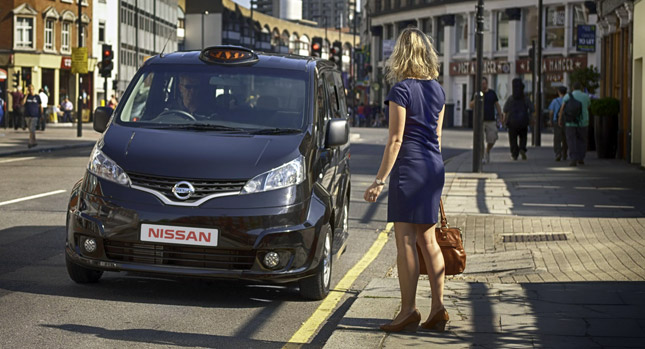After winning the hearts and minds of New York City officials with the NV200 Yellow Cab, Nissan is aiming to do the same in the city of London.
While athletes from all over the world compete in the 2012 London Olympic Games, Nissan presented its vision for the city’s black cab of the future aptly named the ‘NV200 London Taxi’.
You may have noticed from the pictures that the ‘black cab’ version of the NV200 features a visibly wider front track (200mm to be precise) than the NYC model with blistered wheel arches as well as new side steps.
This is because Nissan had to re-engineer the NV200 in order to conform with the regulations set in the TfL London Taxi Conditions of Fitness and which include being able to accommodate a wheelchair passenger and achieve a 25ft (7.6m) turning-circle.
The NV200 London Taxi comes equipped with sliding passenger doors and can seat five adults excluding the driver: three on the rear bench and two on rear-facing, fold-down seats. Nissan removed the front passenger seat to create space for luggage.
Whereas the NYC Yellow Cab model is powered by a 2.0-liter four-cylinder petrol engine, the Black Cab version of the NV200 is fitted with a 1.5-liter turbo-charged diesel available with two power outputs: 89hp and 110hp.
Versions fitted with the 89hp engine feature a five-speed manual gearbox, while 110hp variants benefit from a six-speed unit. Both powerplants are fully compliant with the latest EuroV emissions regulations.
The 89hp engine returns a combined fuel economy of 53.3mpg UK (44.1mpg US or 5.3lt/100km) with CO2 emissions that start from 139g/km. Nissan claims that the NV200 offers 50 percent better fuel economy than the most efficient London black cab today
“Fuel costs account for around 10 percent of taxi driver overheads,” says Nissan. “Over the course of a year, NV200 London Taxi drivers would spend around 50% less – about £700 – on fuel than TX4 drivers,” the company added.
According to the Japanese automaker, the diesel version of the NV200 London Taxi is expected to be competitively priced below the new TX4, the London Taxi Company’s current model.
“As a relevant simulation, if all of London’s licensed taxis were replaced with the NV200 London Taxi, there would be a CO2 reduction across London of 37,970 metric tonnes each year – the equivalent of planting 10,000 acres, or two Congestion Charge zones, of trees every 12 months,” the Japanese company said.
Pending testing, which includes a crash-test, the diesel-powered NV200 aims to receive full London Taxi certification later this year and go on sale during the course of 2013.
Aside from the diesel model, Nissan is also developing an all-electric version named e-NV200 London Taxi.
“With running costs estimated to be around one fifth of a conventional, diesel-powered Hackney Carriage [another name for the London Black Cab] it is likely to be popular with drivers too,” said Nissan.
PHOTO GALLERY
PHOTO GALLERY





























